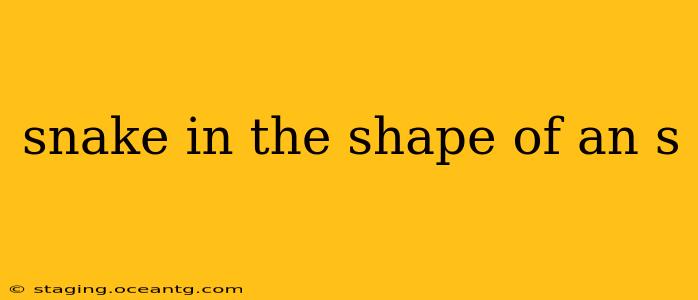Decoding the S-Shaped Snake: Symbolism, Species, and More
Have you ever seen a snake curled into the shape of an "S"? This intriguing posture isn't just a random coil; it holds significance across various cultures and contexts. This article delves into the possible reasons behind this specific snake shape, exploring its symbolism, the species likely to adopt this pose, and more.
What does it mean when a snake is in an S shape?
The "S" shape in snakes is often associated with preparedness and defense. The coiled position allows the snake to quickly strike or launch itself forward, making it a highly effective ambush predator. This isn't a random curl; it's a strategic positioning that maximizes the snake's potential for both defense against threats and efficient hunting. The curve also helps conserve energy; it's a relaxed yet ready posture.
What kind of snakes form an S shape?
Many non-venomous and venomous snake species can be observed in an "S" shape. However, it's more commonly seen in snakes that rely on ambush predation, such as:
- Rattlesnakes: Known for their characteristic rattle, rattlesnakes often assume an "S" shape before striking, making their attack both swift and powerful. The coiled form allows them to generate the necessary force for a successful strike.
- Copperheads: These venomous snakes also utilize the "S" shape for striking, relying on their camouflage and coiled posture to ambush unsuspecting prey.
- Hognose snakes: Though less aggressive than rattlesnakes or copperheads, hognose snakes are known for their defensive behavior, often curling into an "S" to appear larger and more intimidating. They may even play dead as a last resort.
- Other colubrids and vipers: Numerous other snake species from various families will adopt this posture, particularly when feeling threatened or preparing to strike. The specific species will vary depending on geographic location.
It's crucial to remember that observing a snake in this posture doesn't automatically mean it's about to strike. While it indicates alertness and readiness, it's important to maintain a safe distance and avoid provoking it.
Why do snakes coil into an S shape?
The "S" coil is a combination of several advantageous factors for snakes:
- Enhanced striking power: The coiled position allows for a powerful and accurate strike, maximizing the effectiveness of the snake's venom or bite.
- Defensive posture: The "S" shape makes the snake appear larger and more threatening, deterring potential predators.
- Energy conservation: Maintaining a coiled position requires less energy than continuously moving or remaining tense.
- Camouflage: The shape can help blend with the surroundings, especially in snakes with mottled or cryptic coloration.
Is an S-shaped snake dangerous?
Whether an S-shaped snake is dangerous depends entirely on the species. Some are highly venomous, while others are harmless or only mildly venomous. Never attempt to handle any snake, regardless of its shape or apparent temperament. It's always best to maintain a safe distance and admire them from afar.
What should I do if I see a snake in an S shape?
If you encounter a snake in an "S" shape, the best course of action is to slowly back away without making any sudden movements. Avoid making eye contact and never try to approach or handle it. If the snake is in a location that poses a threat, contact your local wildlife authorities or animal control for assistance.
This article aimed to explore the multifaceted aspects of the "S" shaped snake, encompassing its behavioral, symbolic, and safety implications. Remember, responsible observation and respect for wildlife are crucial for both human safety and the preservation of these fascinating creatures.
